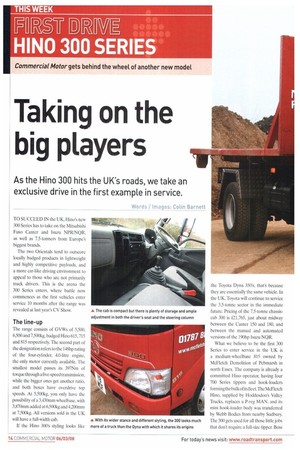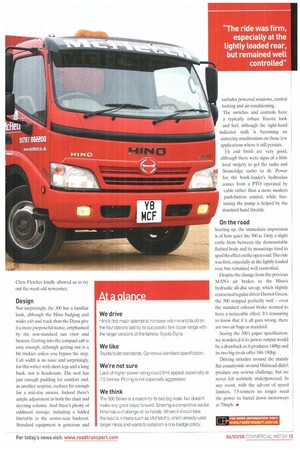Taking on the big players
Page 14

Page 15

If you've noticed an error in this article please click here to report it so we can fix it.
As the Hino 300 hits the UK's roads, we take an exclusive drive in the first example in service.
Words / Images: Colin Barnett TO SUCCEED IN the UK, Hino's new 300 Series has to take on the Mitsubishi Fuso Canter and Isuzu NPR/NOR, as well as 7.5-tonners from Europe's biggest brands.
The two Orientals tend to outscore locally badged products in lightweight and highly competitive payloads, and a more car-like driving environment to appeal to those who are not primarily truck drivers. This is the arena the 300 Series enters, where battle now commences as the first vehicles enter service 10 months after the range was revealed at last year's CV Show.
The line-up The range consists of GVWs of 5,500, 6,500 and 7,500kg, badged Hino 615,715 and 815 respectively. The second part of the designation refers to the 148hp rating of the four-cylinder, 4.0-litre engine, the only motor currently available. The smallest model passes its 397Nm of torque through a five-speed transmission, while the bigger ones get another ratio, and both boxes have overdrive top speeds. At 5,500kg, you only have the possibility of a 3,430mm wheelbase, with 3.870nun added at 6,500kg and 4,200mm at 7,500kg. All versions sold in the UK will have a full-width cab.
If the Hino 300's styling looks like the Toyota Dyna 350's, that's because they are essentially the same vehicle. In the UK, Toyota will continue to service the 3.5-tonne sector in the immediate future. Pricing of the 7.5-tonne chassiscab 300 is £21,765, just about midway between the Canter 150 and 180, and between the manual and automated versions of the 190hp Isuzu NQR.
What we believe to be the first 300 Series to enter service in the UK is a medium-wheelbase 815 owned by McRetch Demolition of Pebmarsh in north Essex. The company is already a committed Hino operator, having four 700 Series tippers and hook-loaders formi ng the bu lk of its fleet. The McFletch Hino, supplied by Hoddesdon's Valley Trucks, replaces a P-reg MAN, and its mini hook-loader body was transferred by Webb Bodies from nearby Sudbury. The 300 gets used for all those little jobs that don't require a full-size tipper. Boss Chris Fletcher kindly allowed us to try out the week-old newcomer.
Design
Not surprisingly, the 300 has a familiar look, although the Hino badging and wider cab and track than the Dyna give it a more purposeful stance, emphasised by the non-standard sun visor and beacon. Getting into the compact cab is easy enough, although getting out is a bit trickier unless you bypass the step. Cab width is no issue and surprisingly, for this writer with short legs and a long back, nor is headroom. The seat has just enough padding for comfort and, as another surprise, reclines far enough for a mid-day snooze. Indeed there's ample adjustment in both the chair and steering column. And there's plenty of oddment storage, including a lidded bin/table in the centre-seat backrest Standard equipment is generous and includes powered windows, central locking and air-conditioning.
The switches and controls have a typically robust Toyota look and feel, although the right-hand indicator stalk is becoming an annoying anachronism on those few applications where it still persists. Fit and finish are very good, although there were signs of a little local surgery to get the radio and Stoneridge tacho to fit. Power for the hook-loader's hydraulics comes from a ITFO operated by cable rather than a more modern push-button control, while finetuning the pump is helped by the standard hand throttle.
On the road
Starting up, the immediate impression is of how quiet the 300 is. Only a slight rattle from between the demountable flatbed body and its mountings tried to spoil the effect on the open road. The ride was firm, especially at the lightly loaded rear, but remained well controlled.
Despite the change from the previous MAN's air brakes to the Hino's hydraulic all-disc set-up, which slightly concerned regular driver Darren Green, the 300 stopped perfectly well — even the standard exhaust brake seemed to have a noticeable effect. It's reassuring to know that if it all goes wrong, there are two air bags as standard.
Seeing the 300's paper specification, we wondered if its power output would be a drawback as it produces 148hp and its two big rivals offer 180-190hp.
Driving unladen around the mainly flat countryside around Halstead didn't produce any serious challenge, but we never felt seriously underpowered. In any event, with the advent of speed limiters, 7.5-tonners no longer need the power to barrel down motorways at 70mph. •












































































































































































